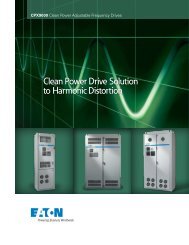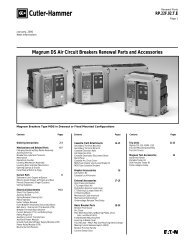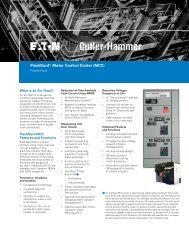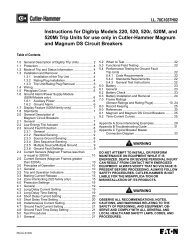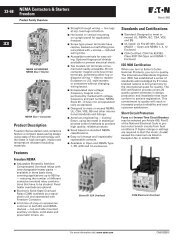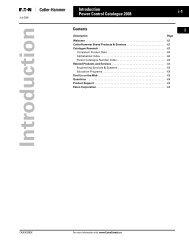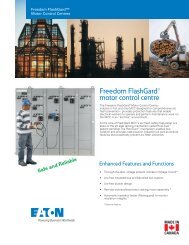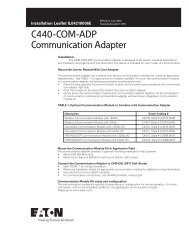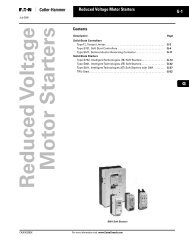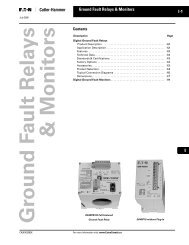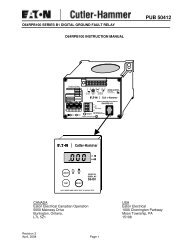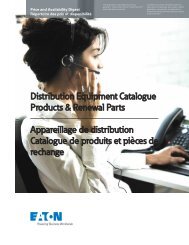Cutler-Hammer Busway Systems - Eaton Canada
Cutler-Hammer Busway Systems - Eaton Canada
Cutler-Hammer Busway Systems - Eaton Canada
Create successful ePaper yourself
Turn your PDF publications into a flip-book with our unique Google optimized e-Paper software.
January 2001<br />
Supersedes Application Data 30-560,<br />
pages 1-28, dated March 1996<br />
In This Section<br />
Item Page<br />
Pow-R-Way II Design (225-400<br />
Amps Only) 2, 3, 7<br />
Pow-R-Way Design (600-5000<br />
Amps 4-6, 8, 9<br />
Fittings 10-21<br />
Hangers 22<br />
Plug-in Devices 23-25<br />
Line-to-Line Voltage Drop 26<br />
Engineering, Test Data 27<br />
Dimensions and Weights 27<br />
Typical Specifications 28<br />
Warning: There is a hazard of electrical<br />
shock or burn whenever working<br />
in or around electrical equipment.<br />
Dimensions not to be used for construction<br />
purposes. Contact <strong>Busway</strong> Marketing<br />
to confirm dimensions.<br />
<strong>Cutler</strong>-<strong>Hammer</strong><br />
<strong>Busway</strong> <strong>Systems</strong><br />
Application Data<br />
30-560<br />
Page 1
Application Data<br />
30-560<br />
Page 2 <strong>Cutler</strong>-<strong>Hammer</strong><br />
Pow-R-Way ® <strong>Busway</strong> <strong>Systems</strong><br />
Pow-R-Way II <strong>Busway</strong><br />
(225-400 Amperes Only)<br />
<strong>Eaton</strong>’s <strong>Cutler</strong>-<strong>Hammer</strong> Pow-R-Way II<br />
single bolt per bar busway (225 and 400<br />
amperes only) was designed to provide an<br />
economical system, yet meet the specification<br />
which are the most important.<br />
Totally enclosed and non-ventilated, it is<br />
available in indoor plug-in and indoor<br />
feeder which can be used interchangeably<br />
without adaptors or special splice plates.<br />
(Not available for outdoor applications.)<br />
Pow-R-Way II is available with aluminum<br />
or copper bus bars in ratings of 225 and<br />
400 amperes only. The following systems<br />
are available:<br />
3-phase, 3-wire<br />
3-phase, 3-wire with 50% internal<br />
ground<br />
3-phase, 4-wire, full neutral<br />
3-phase, 4-wire, full neutral with 50%<br />
internal ground<br />
All 3-wire systems have a maximum voltage<br />
rating of 600 volts and all 4-wire systems<br />
have a maximum of 347/600 volts.<br />
Pow-R-Way II can be mounted in flatwise,<br />
or edgewise, without derating. When the<br />
busway is mounted with the bus bars in<br />
the flatwise position, hangers may be on<br />
10 ft.-0 in. max. centers. When the busway<br />
is mounted with the bus bars in<br />
the edgewise position, hangers must<br />
be on 5 ft.-0 in. max. centers. Firestops<br />
are required when passing through<br />
walls or floors. When applying Pow-R-Way<br />
II in vertical risers, the <strong>Busway</strong> Division<br />
must be advised.<br />
Pow-R-Way II busway is listed by Underwriters<br />
Laboratories, Inc. and is manufactured<br />
in accordance with NEMA standards<br />
for busway.<br />
Construction<br />
Housing<br />
Pow-R-Way II busway uses an all bolted<br />
housing. It is pretreated and then painted<br />
ANSI #61 gray baked-on enamel applied<br />
by an electro-coat process. (See typical<br />
construction details.)<br />
Bus Bars<br />
The bus bars run straight through the<br />
housing and remain on 13/16 inch centers.<br />
They are insulated their entire length by a<br />
uniform layer of epoxy which is a Class B<br />
(130 o C) material. This insulation is applied<br />
utilizing the fluidized bed process. The<br />
bus bars are silver plated at all contact<br />
surfaces. The bus bars are held firmly in<br />
place by high strength molded polyester<br />
glass insulators.<br />
An optional 50% internal ground bar is<br />
available in either copper or aluminum.<br />
The ground bar is bolted to the housing at<br />
each joint, thus ensuring a good ground<br />
path through the entire housing.<br />
Plug-in Openings<br />
Plug-in openings are on 24-inch centers<br />
Typical Plug-in Straight Length<br />
Plug-in Straight Length With Side Channel Removed<br />
Typical Construction Details<br />
and are identical to the plug-in openings<br />
of 600A through 4000A Pow-R-Way. Thus,<br />
plug-in units are interchangeable with all<br />
ratings or Pow-R-Way. (See photo below.)<br />
Joint<br />
The joint of Pow-R-Way II utilizes one cap-<br />
Typical Plug-in Opening<br />
March 2001
<strong>Cutler</strong>-<strong>Hammer</strong><br />
tive bolt per bar making for as labor-free<br />
a joint connection as possible. The left<br />
end of every section of Pow-R-Way II has<br />
offset bus bars with 5/16 inch diameter<br />
hex head bolts which are held captive<br />
by threaded steel inserts. Hex head bolts<br />
have flanged head which evenly distributes<br />
pressure over the entire width of the<br />
bus bar. The right end has straight bus<br />
bars with open slots.<br />
The ends of the bus bars are staggered<br />
to assure adequate electrical clearances<br />
between phases. The joint is made up by<br />
simply tightening the joint bolts to 20-25<br />
ft.-lbs. and then installing the two joint<br />
covers.<br />
Tightening the four captive bolts on each<br />
joint cover completes the assembly and<br />
provides a good mechanical connection<br />
between sections. The joint covers<br />
are identical with the ones used on 600<br />
through 5000 ampere Pow-R-Way.<br />
March 2001<br />
Exploded View of Joint Details<br />
Assembled Joint Without Covers<br />
Assembled Joint<br />
Application Data<br />
30-560<br />
Page 3<br />
Pow-R-Way ® <strong>Busway</strong> <strong>Systems</strong>
Application Data<br />
30-560<br />
Page 4 <strong>Cutler</strong>-<strong>Hammer</strong><br />
Pow-R-Way ® <strong>Busway</strong> <strong>Systems</strong><br />
Pow-R-Way <strong>Busway</strong><br />
(600-5000 Amperes)<br />
The <strong>Cutler</strong>-<strong>Hammer</strong> Pow-R-Way (600-5000<br />
amperes) busway is totally enclosed and<br />
non-ventilated, it is available in three<br />
forms: outdoor feeder, indoor feeder,<br />
and indoor plug-in which can be used<br />
interchangeably without adaptors or<br />
special splice plates. This eliminates the<br />
need for a variety of busway types in the<br />
construction of a complete low-voltage<br />
power distribution system. One set of fittings-elbows,<br />
tees, flanges, etc. has been<br />
designed for use with both the plug-in<br />
and feeder types of POW-R-WAY busway,<br />
complementing even more the flexibility<br />
of the POW-R-WAY system.<br />
Construction<br />
General<br />
POW-R-WAY busway is one basic design<br />
which can be supplied as indoor plug-in,<br />
indoor feeder, or outdoor feeder. POW-R-<br />
WAY busway is available with aluminum<br />
bus bars in ratings from 600-4000 amps.<br />
and with copper bus ratings from<br />
600-5000 amps.<br />
The following systems are available:<br />
3-phase, 3-wire<br />
3-phase, 3-wire with 50% internal<br />
ground<br />
3-phase, 4-wire, FN<br />
3-phase, 4-wire, FN, with 50% internal<br />
ground<br />
All 3-wire systems have a maximum<br />
voltage rating of 600 volts and all 4-wire<br />
systems have a maximum of 347/600<br />
volts. One hanger is supplied for every 10<br />
feet of horizontally mounted duct. POW-R-<br />
WAY busway can be mounted in flatwise,<br />
edgewise, or vertical positions without<br />
derating. POW-R-WAY busway is listed<br />
by Underwriters Laboratories, Inc. and is<br />
manufactured in accordance with NEMA<br />
standards for busway.<br />
Housing (See right)<br />
The duct housing is made of 14 and 16<br />
gauge steel. It is bonderized inside and<br />
outside and given one coat of ASA #61<br />
light gray baked-on enamel applied by an<br />
electro-coat process. The bottom channel<br />
is spot welded to the “C” covers (1) and<br />
the top channel is bolted to the “C” covers<br />
using 1/4-20 high tensile strength (100,000<br />
psi) bolts, located on 4-inch max. centers.<br />
Bus Bar and Insulation (See below)<br />
Full rounded edge bus bars (6) are available<br />
in either high strength 55% minimum<br />
conductivity aluminum or 98% conductivity<br />
pure copper. The bus bars are silver<br />
plated at all contact surfaces.<br />
Each bus bar is covered with a uniform<br />
March 2001
<strong>Cutler</strong>-<strong>Hammer</strong><br />
layer of epoxy insulation (5), which is<br />
a Class B (130 o C) material. This epoxy<br />
insulation is applied by the fluidized bed<br />
process, which ensures a smooth, even,<br />
continuous insulation and eliminates hand<br />
taping.<br />
An optional 50% internal ground bus bar<br />
(2) is available in either copper or aluminum.<br />
Joint<br />
Bus bars on the left-end (bolt end) of a<br />
busway section are flared out and have a<br />
closed slot. The left end also has an insulated<br />
captive joint bolt. This joint bolt must<br />
be tightened to 30 ft.-lbs. torque for 2-inch<br />
and 2 1/2-inch wide bus bars, and 60 ft.-lbs.<br />
torque for 3-inch and wider bus bars. For<br />
6-inch, 6 1/2-inch and 7 1/2-inch wide bus bars,<br />
two joint bolts are used to assure good<br />
electrical contact between bus bars. Bolt<br />
retainers, which keep bolt head from turning,<br />
can easily be moved to the opposite<br />
side of the duct by removing two #10-32<br />
retainer screws. Also captive to the left-end<br />
are two belleville washers which evenly<br />
distribute pressure over the entire contact<br />
area.<br />
High strength molded polyester glass joint<br />
insulators are inserted between opposite<br />
phases of bus bars and between bus bars<br />
and the housing. This provides adequate<br />
over the surface electrical clearances and<br />
mechanical strength for the joint.<br />
Bus bars on the right-end (slot end) of a<br />
busway section are flared and have an<br />
open slot to accept the captive joint bolt.<br />
Joint insulators on this end also have an<br />
open slot.<br />
Joint covers with captive hardware<br />
complete the housing joint giving a good<br />
mechanical connection between sections.<br />
The same universal joint cover is used for<br />
all ratings of Pow-R-Way, 225-5000<br />
Amperes, both plug-in and feeder.<br />
Note: Pow-R-Way plug-in design with bus<br />
bars under 3-inch wide (225-600 Aluminum<br />
or 225-800A Copper) requires 10 1/4<br />
inches to joint centerline when passing<br />
through walls or floors. This is necessary<br />
to keep joint covers clear of walls and<br />
floors.<br />
March 2001<br />
Exploded View of Joint Details<br />
Application Data<br />
30-560<br />
Page 5<br />
Pow-R-Way ® <strong>Busway</strong> <strong>Systems</strong>
Application Data<br />
30-560<br />
Page 6 <strong>Cutler</strong>-<strong>Hammer</strong><br />
Pow-R-Way ® <strong>Busway</strong> <strong>Systems</strong><br />
Plug-in Openings<br />
Plug-in openings are on 24-inch centers.<br />
Plug-in opening doors have a formed<br />
hinge and remain on duct at all times.<br />
At each plug-in opening, the bus bars are<br />
flared out to 13/16-inch centers to allow<br />
plug-in stabs to engage bus bars. High<br />
strength molded polyester glass plug-in<br />
insulators provide protection of the duct<br />
in the event of stresses due to a fault and<br />
provide full isolation of the stabs of any<br />
plug-in device installed on the duct.<br />
Outdoor Pow-R-Way Design<br />
Sealing Compound<br />
Drain Holes<br />
Joint Gaskets<br />
Pow-R-Way outdoor duct is the same<br />
design as indoor duct except for the following<br />
features as shown above:<br />
• Gasket splice plates with removable<br />
drain plugs are supplied to cover joint<br />
bolt.<br />
• Special outdoor joint covers with<br />
removable drain plugs.<br />
• All four sides of duct have neoprene<br />
gasketing to seal out all water.<br />
Assembled Joint, Outdoor Pow-R-Way<br />
Splice Cover<br />
Removable Drain Plug<br />
Joint Cover<br />
• Housing is of galvanized steel and has<br />
drain holes.<br />
• All seams are sealed with sealing<br />
compound.<br />
CAUTION<br />
After <strong>Busway</strong> Joint has been assembled,<br />
remove and discard all rubber drain plugs<br />
located on the underside of the duct.<br />
Pow-R-Way II Straight Lengths<br />
Drain Holes<br />
March 2001
<strong>Cutler</strong>-<strong>Hammer</strong><br />
(225-400 Amperes Only) Indoor Only<br />
Plug-in Straight Lengths<br />
Straight lengths of Pow-R-Way II plug-in<br />
busway are supplied only in 2, 4, 6, 8 and<br />
10 foot lengths to maintain 24-inch spacing<br />
for plug-in openings.<br />
Risers<br />
Refer to <strong>Cutler</strong>-<strong>Hammer</strong>.<br />
Feeder Straight Lengths<br />
Straight lengths of feeder busway can be<br />
supplied in any length from 24-inch to<br />
10-feet.<br />
March 2001<br />
Typical Plug-in Straight Length<br />
Typical Feeder Straight Length<br />
Dimensions in Inches<br />
Application Data<br />
30-560<br />
Page 7<br />
Pow-R-Way ® <strong>Busway</strong> <strong>Systems</strong>
Application Data<br />
30-560<br />
Page 8 <strong>Cutler</strong>-<strong>Hammer</strong><br />
Pow-R-Way ® <strong>Busway</strong> <strong>Systems</strong><br />
Pow-R-Way Straight Lengths<br />
(600-5000 Amperes)<br />
Plug-in Straight Lengths<br />
Straight lengths of plug-in busway are<br />
supplied only in 2, 4, 6, 8, and 10 foot<br />
lengths, with the exception that 2-feet<br />
lengths are not available in aluminum for<br />
600 amps, and in copper for 600 and<br />
800 amps.<br />
In all two and three bar per phase arrangements,<br />
tie bars between like phases<br />
are added in order to electrically balance<br />
the busway.<br />
Figures A through D illustrate configuration<br />
of duct for available ampere ratings.<br />
See Table A for reference to proper figure.<br />
Table B shows number of plug-in openings<br />
available for standard lengths.<br />
Dimensions in Inches<br />
March 2001
<strong>Cutler</strong>-<strong>Hammer</strong><br />
Pow-R-Way Straight Lengths<br />
(600-5000 Amperes)<br />
Feeder Straight Lengths<br />
Dimensions in Inches<br />
March 2001<br />
Application Data<br />
30-560<br />
Page 9<br />
Pow-R-Way ® <strong>Busway</strong> <strong>Systems</strong><br />
Straight lengths of feeder busway can be<br />
supplied in any length from 24 in. to<br />
10 ft.-0 in.<br />
Figures A through D illustrate configuration<br />
of duct for available ampere ratings.<br />
See table below for reference to proper<br />
figure.
Application Data<br />
30-560<br />
Page 10 <strong>Cutler</strong>-<strong>Hammer</strong><br />
Pow-R-Way ® <strong>Busway</strong> <strong>Systems</strong><br />
Fittings for Pow-R-Way II and<br />
Pow-R-Way <strong>Busway</strong><br />
There is a basic fitting to meet every application<br />
need: flanges, elbows, offsets,<br />
tees, cable tap boxes, weatherheads,<br />
transformer connections, power take off<br />
sections, reducers, adapter cubicles, expansion<br />
joints and end closers. These fittings,<br />
along with standard and minimum dimensions<br />
are described on the following pages.<br />
When making field measurements and<br />
layouts, it should be remembered that<br />
dimensions of fittings are given from<br />
the centerline of the busway. Relationship<br />
of fitttings to straight lengths is<br />
illustrated at right.<br />
Assembled sections of busway are marked<br />
“T” for top and “F” for front. When assembling<br />
the system, “T” and “F” markings of<br />
adjacent sections must match.<br />
Flanges➀<br />
Flanges join busway housing to the<br />
switchgear or other apparatus and include<br />
standardized bus extensions for electrical<br />
connection.<br />
When busway extends into switchgear,<br />
switchboards or motor control centers,<br />
the opening and flange drillings must be<br />
provided by the switchgear builder. In<br />
which case, the cutout dimensions and<br />
drilling plan must be followed. For proper<br />
coordination between busway and any<br />
equipment, detailed drawings must accompany<br />
the order.<br />
Flange can be supplied on left or right of<br />
Rearward<br />
Upward<br />
Downward<br />
Forward<br />
section, as required. Minimum dimensions<br />
are shown in the tables below.<br />
Flush Flanges<br />
Flush Flange is used when duct must lay<br />
flat on top of a switchboard. Flange can be<br />
supplied on left or right end of section, as<br />
required. Extensions can extend out of top<br />
or bottom as required.<br />
➀ Flange hardware to be supplied by others.<br />
➁ Dimensional purposes only. Pow-R-Way II is<br />
standard design in this rating.<br />
March 2001
<strong>Cutler</strong>-<strong>Hammer</strong><br />
Fittings, Continued<br />
Elbows<br />
Elbows are used to make 90 o changes in<br />
the direction of busway runs. There are<br />
four types available.<br />
See minimum leg lengths in tables.<br />
➀ Pow-R-Way II is standard design in this rating.<br />
March 2001<br />
Application Data<br />
30-560<br />
Page 11<br />
Pow-R-Way ® <strong>Busway</strong> <strong>Systems</strong>
Application Data<br />
30-560<br />
Page 12 <strong>Cutler</strong>-<strong>Hammer</strong><br />
Pow-R-Way ® <strong>Busway</strong> <strong>Systems</strong><br />
Fittings, Continued<br />
Elbow Flanges➀<br />
Flanges can be supplied on end of right or<br />
left leg as required. Minimum leg lengths<br />
are shown below.<br />
➀ Flange hardware to be supplied by others.<br />
➁ Pow-R-Way II is standard design in this rating.<br />
March 2001
<strong>Cutler</strong>-<strong>Hammer</strong><br />
Fittings, Continued<br />
Offsets<br />
An offset is used to avoid obstacles and<br />
to conform with building structure. It is<br />
simply two elbows fabricated into one<br />
unit for use where it is impossible to use a<br />
standard elbow because of space restrictions.<br />
Minimum leg lengths are shown below.<br />
➀ Pow-R-Way II is standard design in this rating.<br />
➁ For outdoor duct, add 1 3/4 inches.<br />
March 2001<br />
Application Data<br />
30-560<br />
Page 13<br />
Pow-R-Way ® <strong>Busway</strong> <strong>Systems</strong>
Application Data<br />
30-560<br />
Page 14 <strong>Cutler</strong>-<strong>Hammer</strong><br />
Pow-R-Way ® <strong>Busway</strong> <strong>Systems</strong><br />
Fittings, Continued<br />
Tees<br />
A tee is a busway fitting suitable for connection in three directions. Minimum lengths<br />
are shown below.<br />
➀ Pow-R-Way II is standard design in three rating.<br />
➁ For outdoor duct, add 1 3/4 inches.<br />
➂ For outdoor duct, add 1 inch.<br />
March 2001
<strong>Cutler</strong>-<strong>Hammer</strong><br />
Fittings, Continued<br />
Crosses<br />
A cross is a busway fitting suitable for<br />
connection in four directions. It is used<br />
where a run of duct branches off in three<br />
directions in the same plane.<br />
Expansion Joint<br />
Expansion joints accommodate the expansion<br />
and contraction of bus bars with<br />
respect to the enclosure. They are necessary<br />
to compensate for the difference in the<br />
coefficient of expansion of steel housing and<br />
copper or aluminum bus bars.<br />
An expansion joint should be installed in the<br />
center of extremely long runs of the busway.<br />
If such runs have an end closer at one end,<br />
so that the bus bars are free to move, or if<br />
the run contains elbows, expansion joint<br />
may be omitted.<br />
Expansion joints must also be used wherever<br />
a run of busway crosses an expansion<br />
joint in a building. The use of expansion<br />
joints should be engineered for individual<br />
installations.<br />
➀ Dimensional purposes only. Pow-R-Way II is standard<br />
design in this rating.<br />
➁ 225A and 400A (Pow-R-Way II) is 5 1¦32 inches total width.<br />
➂ B dimension is centered on “F” side of duct.<br />
March 2001<br />
Application Data<br />
30-560<br />
Page 15<br />
Pow-R-Way ® <strong>Busway</strong> <strong>Systems</strong><br />
Dimensions in Inches
Application Data<br />
30-560<br />
Page 16 <strong>Cutler</strong>-<strong>Hammer</strong><br />
Pow-R-Way ® <strong>Busway</strong> <strong>Systems</strong><br />
Fittings, Continued<br />
End Cable Tap Box<br />
End cable tap boxes are used where a run<br />
of duct is fed at the end by cable and<br />
conduit, or where equipment served by<br />
Center Cable Tap Box<br />
Center cable tap boxes are used where<br />
a run of duct is center fed by cable and<br />
conduit, or where equipment served by<br />
the duct is connected without overcurrent<br />
protection.<br />
➀ Pow-R-Way II is standard design in this rating.<br />
➁ For outdoor end cable tap box add 1/4 in. to A and B dimensions, 1/8 in. to E dimension<br />
and 2 in. to G dimension and “T” must be on top for horizontal runs.<br />
➂ #6-250 MCM lugs.<br />
➀ Pow-R-Way II is standard design in these rating.<br />
➁ Add 2 inches for outdoor cable tap box.<br />
➂ #6-250 MCM lugs.<br />
Plug-in Cable Tap Box<br />
Plug-in cable tap boxes are used to feed<br />
the busway run, or where equipment<br />
served by the busway is connected without<br />
overcurrent protection. Plug-in cable<br />
tap boxes plug into any Pow-R-Way busway<br />
(225-4000 amps) plug-in openings.<br />
the duct is connected without overcurrent<br />
protection.<br />
Note: Add 1/4 inch to A, B dimensions for<br />
outdoor cable tap box and “T” must be on<br />
top for horizontal runs.<br />
▲<br />
March 2001<br />
Removable
<strong>Cutler</strong>-<strong>Hammer</strong><br />
Fittings, Continued<br />
A weatherhead is used where power is fed<br />
into a building by cable from a utility service<br />
drop, or from a transformer. Cables<br />
enter bottom of weatherhead per N. E. C.<br />
drip loop requirements.<br />
➀ T and F marking must be shown.<br />
March 2001<br />
End closers terminate run of duct and can<br />
be used to close either the right or left<br />
end.<br />
Application Data<br />
30-560<br />
Page 17<br />
Pow-R-Way ® <strong>Busway</strong> <strong>Systems</strong>
Application Data<br />
30-560<br />
Page 18 <strong>Cutler</strong>-<strong>Hammer</strong><br />
Pow-R-Way ® <strong>Busway</strong> <strong>Systems</strong><br />
Fittings, Continued<br />
Single-Phase Transformer Tap<br />
This type of transformer tap arrangement<br />
is used when making connections to three<br />
single-phase transformers. The bus extensions<br />
do not include drilling or lugs unless<br />
specified on the order.<br />
Three-Phase Transformer Tap<br />
This type of transformer tap arrangement<br />
is used when making connections to a<br />
3-phase transformer. The bus extensions<br />
do not include drilling or lugs unless<br />
specified on the order.<br />
Transformer Throat Connections<br />
All transformer throat connections include<br />
flexible connectors between transformer<br />
low-voltage studs and bus bars. For transformer<br />
with drilled flanges, busway will bolt<br />
to throat instead of using a<br />
sealing ring.<br />
Transformer Taps<br />
➀ Pow-R-Way II is standard design in these<br />
ratings.<br />
➁ For outdoor duct, add 3 1/2 inches.<br />
➂ For outdoor duct, add 3/4 inch.<br />
March 2001
<strong>Cutler</strong>-<strong>Hammer</strong><br />
Power Take-off Sections➁➂<br />
Power take-off sections are used in the following situations:<br />
1. To take large amounts of power off a run (beyond the current<br />
carrying capabilities of plug-in stabs).<br />
2. Where space restrictions dictate that the wide dimensions<br />
of the busway be flat against a wall or ceiling or other obstructions,<br />
bolt-on units are used instead of plug-in units.<br />
3. Where panelboards are mounted on busway.<br />
The plug-in power take-off is a design that permits the take-off<br />
of power (1600A max.) at a standard plug-in opening. The molded<br />
insulator in the opening is removed completely. The power<br />
take-off conductor is inserted into the opening until contact is<br />
made with the bus bars in the bus duct. A single bolt design in<br />
the power take-off is then torqued to 60 ft.-lb., permitting 1600A<br />
maximum capacity.<br />
The bolt-on circuit breaker, fusible switch or tap box is then<br />
bolted to the power take-off by solid buswork. The plug-in power<br />
take-off cannot, in itself, be used as a cable tap box. An overcurrent<br />
protective device must be priced with the power take-off.<br />
This device for load applications as shown.<br />
➀ Right leg must be 24 inches.<br />
➁ When laying out the bus run, “T” and “F” must be shown.<br />
➂ Built-in power take-off device, 1250-amp max.<br />
Dimensions in Inches<br />
March 2001<br />
Dimensions in Inches<br />
Built-in Power Take-off (1250 Amp Max)<br />
Application Data<br />
30-560<br />
Page 19<br />
Pow-R-Way ® <strong>Busway</strong> <strong>Systems</strong>
Application Data<br />
30-560<br />
Page 20 <strong>Cutler</strong>-<strong>Hammer</strong><br />
Pow-R-Way ® <strong>Busway</strong> <strong>Systems</strong><br />
Fittings, Continued<br />
Non-Fused Reducers<br />
Non-fused reducers are used to reduce<br />
the capacity of busway without overcurrent<br />
protective devices. No overcurrent<br />
protection is required where busway is<br />
reduced in size, provided the length of the<br />
smaller duct does not extend more than<br />
50 feet and has a current rating of at least<br />
1/3 of the overcurrent device next back on<br />
the line. (See NEC Section 364-11.)<br />
Circuit Breaker or Fused Reducer<br />
Reducer cubicles are available with either<br />
a circuit breaker or fused non-automatic<br />
circuit breaker to furnish overcurrent<br />
protection and serve as a disconnecting<br />
means. Reduction in bus capacity is made<br />
within the cubicle. The line side of the<br />
cubicle is connected to the large rating<br />
of duct and the load side to the reducing<br />
rating of duct. (Not approved for use as<br />
Dimensions in Inches<br />
service entrance.)<br />
Flatwise-to-flatwise, reduces to left or<br />
right.<br />
➀ Pow-R-Way II is standard design in this rating.<br />
➁ N. E. C. Class H fuses.<br />
➂ Class L fuses.<br />
➃ For height and width dimensions, refer to <strong>Cutler</strong>-<br />
<strong>Hammer</strong>.<br />
<strong>Busway</strong> Plug-In Unit for Connection to<br />
Meter Center Fusible Switch<br />
The main meter center fusible switch can<br />
also be used in conjunction with a Pow-R-<br />
Way plug-in unit. With this device, busway<br />
can be applied to feed meter stacks. These<br />
main service cubicles can be utilized with<br />
either left-or right-hand bus tap connections<br />
as required by building layout. The<br />
meter stacks are then added to the fusible<br />
switch cubicle on the side opposite the<br />
bus tap flange. (Not approved for service<br />
entrance.)<br />
For 400- and 600-amp only.<br />
Dimensions in Inches<br />
March 2001
<strong>Cutler</strong>-<strong>Hammer</strong><br />
Miscellaneous Fittings<br />
Wall Flanges<br />
Wall/floor flanges are used to fit around<br />
busway and close off hole in wall or floor<br />
where duct penetrates.<br />
March 2001<br />
Application Data<br />
30-560<br />
Page 21<br />
Pow-R-Way ® <strong>Busway</strong> <strong>Systems</strong><br />
Roof Flange<br />
A roof flange should be used with outdoor duct where the duct penetrates the roof.<br />
Dimensions in Inches<br />
Joint Puller<br />
A joint puller is available to assist in joining two sections of duct.
Application Data<br />
30-560<br />
Page 22 <strong>Cutler</strong>-<strong>Hammer</strong><br />
Pow-R-Way ® <strong>Busway</strong> <strong>Systems</strong><br />
Hangers for Horizontal Mounting<br />
One hanger is supplied for every 10 feet of horizontally mounted busway. Type of hanger<br />
supplied is determined by the specific mounting requirements of the duct. Types of hangers<br />
are shown below. Drop rods ( 1/2 in. dia.) must be furnished by customer.<br />
Dimensions in Inches<br />
Hangers for Vertical Mounting<br />
When busway is to be installed vertically,<br />
a spring suspension type hanger is furnished.<br />
This unique hanger equalizes the<br />
weight of vertically mounted duct among<br />
all supports. A vertical hanger must be<br />
used on each floor and at the end of the<br />
busway on the last floor. The maximum<br />
span permitted by UL on vertical hangers<br />
is 16 feet. Intermediate hangers are<br />
required if floor heights exceed 16 feet.<br />
Note: Vertical hangers must be priced as<br />
part of busway.<br />
Edgewise<br />
▲<br />
Dimensions in Inches<br />
▲<br />
Flatwise<br />
▲<br />
March 2001
<strong>Cutler</strong>-<strong>Hammer</strong><br />
Plug-in Protective Devices<br />
All Pow-R-Way and Pow-R-Way II plugin<br />
units (both circuit breaker and fusible<br />
types) have the following features:<br />
Personnel Safety (See Fig. 1)<br />
Plug-in units have a dual purpose interlock<br />
to prevent cover from being opened while<br />
the device is in the “ON” position and to<br />
prevent accidental closing of the device<br />
while cover is open. This dual purpose<br />
interlock may be defeated if necessary for<br />
maintenance.<br />
The plug-in unit and the busway are<br />
interlocked to ensure that the device is in<br />
the “OFF” position prior to installation or<br />
removal from the unit (Fig. 2).<br />
The plug-in enclosure is grounded to the<br />
busway housing before the phase and<br />
neutral stabs make contact with the busway<br />
bus bars.<br />
The operating handle remains in control<br />
of the disconnect device at all times.<br />
All plug-in units are polarized to make it<br />
impossible to put plugs on backwards and<br />
have neutral stab touch a phase bar.<br />
The clamp and guide are designed to<br />
allow plug-in units to be hung in place on<br />
horizontal runs prior to insertion of stabs.<br />
Flexibility (See Fig. 3)<br />
Two-position handle location allows<br />
handle to be mounted on the end of the<br />
unit for horizontal runs or on the side of<br />
the unit for vertical runs.<br />
Neutral stab and ground stab are field<br />
mountable.<br />
Backfeeding is an industry-acknowledged<br />
practice whereby incoming power is fed<br />
into the load side of a plug-in unit to feed<br />
a busway run. UL permits “backfeeding”<br />
a circuit breaker, providing it has a noninterchangeable<br />
trip or is a Seltronic-type<br />
breaker.<br />
UL will not permit “backfeeding” a<br />
TRI-PAC ® type circuit breaker or a fusible<br />
plug-in device.<br />
Using <strong>Cutler</strong>-<strong>Hammer</strong> Series C circuit<br />
breaker bus plugs, system interrupting<br />
ratings can be increased up to 100K AIC<br />
(480V) or 200K AIC (240V) when F-(150A),<br />
J-(250A), or K-(400A) frames are used. By<br />
changing out the breaker only and leaving<br />
the enclosure intact, this allows for<br />
flexibility to deal with system short circuit<br />
availability changes (up to the rating of<br />
the busway), as well as downstream protection<br />
through series ratings.<br />
March 2001<br />
Dual Purpose<br />
Interlock<br />
Neutral<br />
Stab<br />
Ground<br />
Stab<br />
Fig. 1. Open View Plug-in Units<br />
Interlock<br />
(Accessible)<br />
Fig. 2. Plug-in Unit Mounted on <strong>Busway</strong><br />
Handle Mounted for<br />
Horizontal Run<br />
Fig. 3. Universal Handle Mounting<br />
Application Data<br />
30-560<br />
Page 23<br />
Pow-R-Way ® <strong>Busway</strong> <strong>Systems</strong><br />
Interlock Defeater<br />
Interlock<br />
(Not Accessible)<br />
Handle Mounted<br />
for Vertical Run<br />
Load End
Application Data<br />
30-560<br />
Page 24 <strong>Cutler</strong>-<strong>Hammer</strong><br />
Pow-R-Way ® <strong>Busway</strong> <strong>Systems</strong><br />
Ground Detector and Neutralizer<br />
Plug-in<br />
In rare cases, bus bars in a busway system<br />
pick up static electricity. In order to<br />
discharge this potential, a neutralizer plug<br />
is available which also serves as a ground<br />
detector. The unit has three 18,000 ohm<br />
resistors connected between the bus bars<br />
and the ground. Static electricity is discharged<br />
through these resistors. A neon<br />
lamp is placed in series with the bus bar<br />
and part of the resistor and burns continuously.<br />
If there is a ground anywhere on<br />
the system which is of lower resistance<br />
than the path through the lamp, the lamp<br />
will go out, indicating that there is a short<br />
in the system. For 3-phase, 3-wire systems<br />
only.<br />
Plug-in Combination Starters and Contactors<br />
Starter<br />
Transformer<br />
Plug-in combination starters or contactors<br />
are mounted in enclosures identical to the<br />
standard circuit breaker or fusible switch<br />
enclosure including safety interlocks and<br />
two-position handle location. They are<br />
available from size 0 through size 4 with a<br />
circuit breaker, MCP or fusible disconnect.<br />
PC SELTRONIC<br />
Breaker Cubicle<br />
24”<br />
3000 Ampere Seltronic Circuit Breaker<br />
In today‘s complex distribution systems<br />
sophisticated solid-state tripping characteristics<br />
are sometimes required on circuit<br />
protective devices. The PC Seltronic circuit<br />
breaker can be used as a main breaker in<br />
a run of duct or as branch feeder protection.<br />
They are available 600 through 3000<br />
amperes with interrupting ratings up to<br />
100,000 AIC symmetrical at 600 volts.<br />
(Not approved for use as service entrance<br />
equipment.)<br />
Control<br />
Circuit<br />
Fuse<br />
MCP or<br />
Breaker<br />
27 3 ¦8”<br />
A 120-volt control transformer fused on the<br />
secondary, selector switches and indicating<br />
lights are available as optional items.<br />
Provisions for neutral stab and/or ground<br />
stab are provided. For outline dimensions<br />
of enclosure refer to <strong>Cutler</strong>-<strong>Hammer</strong>.<br />
Plug-in Device Mounting<br />
The load end of a plug-in unit varies with<br />
the orientation of the busway as determined<br />
by the “F” and “T” markings. See<br />
drawings below.<br />
March 2001
<strong>Cutler</strong>-<strong>Hammer</strong><br />
Dimensions and Weights, Plug-in Units<br />
March 2001<br />
Application Data<br />
30-560<br />
Page 25<br />
Pow-R-Way ® <strong>Busway</strong> <strong>Systems</strong><br />
Dimensions in Inches
Application Data<br />
30-560<br />
Page 26 <strong>Cutler</strong>-<strong>Hammer</strong><br />
Pow-R-Way ® <strong>Busway</strong> <strong>Systems</strong><br />
Dimensions and Weights, Bolt-on Units and Bus Bars<br />
Dimensions in Inches<br />
Dimensions in Inches<br />
March 2001
<strong>Cutler</strong>-<strong>Hammer</strong><br />
Line-to-Line Voltage Drop<br />
The tables below give average 3-phase voltage drop per 100 feet<br />
at rated current and varying power factor. Line-to-neutral voltage<br />
drop is obtained by multiplying the line value by .577.<br />
March 2001<br />
Derating Chart for Higher Ambient<br />
Temperatures<br />
POW-R-WAY busway may be operated<br />
continuously at its assigned ratings<br />
without exceeding the maximum hotspot<br />
temperature rise of 55 o C, provided<br />
the ambient temperature does not<br />
exceed 40 o C. For higher ambient temperatures,<br />
the ratings should be reduced<br />
by applying the appropriate multiplier<br />
shown in chart.<br />
Application Data<br />
30-560<br />
Page 27<br />
Pow-R-Way ® <strong>Busway</strong> <strong>Systems</strong>
Application Data<br />
30-560<br />
Page 28<br />
Pow-R-Way ® <strong>Busway</strong> <strong>Systems</strong><br />
Typical Specifications For<br />
POW-R-WAY <strong>Busway</strong><br />
General<br />
The feeder and/or plug-in busway shall<br />
consist of either aluminum or copper<br />
conductors in a totally enclosed housing<br />
and shall be capable of being mounted in<br />
any position without derating. Plug-in and<br />
feeder sections shall be interchangeable<br />
without the use of special adapter joint covers.<br />
The complete installation shall be coordinated<br />
throughout and, where possible,<br />
shall consist of standard 10-foot sections<br />
with special sections and fittings provided<br />
to suit the installation. Horizontal runs of<br />
busway shall be suitable for hanging on 10<br />
ft.-0 in. maximum support centers. Vertically<br />
mounted busway shall be approved<br />
for that purpose and one adjustable vertical<br />
hanger shall be provided for 16 ft.-0 in.<br />
maximum support centers. Where required,<br />
busway suitable for outdoor service shall<br />
be supplied. An internal ground bar of 50percent<br />
capacity shall be supplied where<br />
called for on the plans or drawings. All<br />
material and installation shall comply with<br />
the applicable standards, practices, and<br />
codes of ASA, IEEE, NEMA and Underwriters<br />
Laboratories, Inc. The busway shall be<br />
listed by Underwriters Laboratories, Inc.<br />
Housing<br />
The housing shall be of the non-ventilated<br />
type meeting NEC requirements and<br />
constructed of code gauge steel which is<br />
pretreated and painted ANSI #61, on both<br />
inside and outside using an electro-coat<br />
process. Plug-in type busway, except for<br />
fittings, shall have provisions for plug-in<br />
openings with a hinged outlet cover<br />
provided for each.<br />
Joint<br />
The joint design of 600 through 5000<br />
ampere busway shall permit safe, practical<br />
testing of its tightness without de-energizing<br />
the run. The joint shall be of the singlebolt<br />
pressure design providing optimum<br />
electrical contact and mechanical strength.<br />
The joint shall be of the overlap type with a<br />
joint bolt which passes through the overlap<br />
to maintain positive pressure. Access to<br />
only one side of the duct need be required<br />
<strong>Cutler</strong>-<strong>Hammer</strong><br />
Pittsburgh, Pennsylvania U.S.A.<br />
March 2001<br />
Printed in U.S.A.<br />
for tightening or inspection of the joint. Any<br />
one section of the duct should be removable<br />
without disturbing adjacent pieces. All<br />
hardware required to make up an indoor<br />
joint shall be captive.<br />
Bus Bars<br />
All bus bars shall be fabricated from either<br />
high-strength, 55% conductivity aluminum<br />
or all shall be of 98% conductivity copper.<br />
Bus bars shall be silver plated at all<br />
electrical contact surfaces. Bus bars shall<br />
be insulated over their entire length, except<br />
at joints and contact surfaces, with epoxy<br />
insulation applied by the fluidized bed<br />
process. This insulation shall be Class B<br />
(130 o C).<br />
Plug-in Openings<br />
On plug-in type busway a suitable support<br />
shall be provided at each plug-in opening to<br />
provide protection of the duct in the event<br />
of stresses due to a fault and to provide<br />
full isolation and polarization of the stabs<br />
of any plug-in device installed in the duct.<br />
When an internal ground bar is included in<br />
the busway, the plug-in support shall also<br />
provide for its positive engagement by the<br />
grounding stab of the plug-in device.<br />
Voltage Drop<br />
The three-phase, line-to-line voltage drop<br />
for the feeder busway shall not exceed 3.32<br />
volts per one-hundred feet (concentrated<br />
load) at 80-percent power factor. The voltage<br />
drop for the plug-in busway shall not<br />
exceed 1.87 volts per one-hundred feet (distributed<br />
load) at 80-percent power factor.<br />
Short-Circuit Bracing<br />
The busway, feeder and/or plug-in, shall be<br />
braced to withstand the maximum available<br />
short-circuit currents as indicated on<br />
the plans and drawings and shall in all<br />
cases be braced for no less than the NEMA<br />
standard for that rating.<br />
Operating Characteristics<br />
The busway shall be so designed and<br />
tested that, at rating, the bus bars shall not<br />
exceed a 55 o C temperature rise based on<br />
a 40 o C ambient temperature. The busway shall<br />
withstand for one minute, without breakdown, the<br />
application of 2200 volts of<br />
60-Hertz alternating potential between conductors,<br />
and between conductors and the enclosure. Each<br />
piece of Pow-R-Way busway is given a 5000-volt<br />
Ac high pot. Test after assembly to ensure that the<br />
insulation system is properly applied.<br />
Plug-In Units<br />
Where required, plug-in units of the types<br />
and ratings indicated on the plans and<br />
specifications shall be supplied. Plug-in<br />
units shall be Underwriters Laboratories,<br />
Inc. listed. Plug-in units shall be mechanically<br />
interlocked with the busway housing<br />
to prevent their installation or removal<br />
while the switch is in the “ON” position. The<br />
enclosure of any plug-in unit shall make<br />
positive ground connection to the duct<br />
housing before the stabs make contact with<br />
the bus bars. A ground stab shall be provided,<br />
where required, to engage the busway<br />
internal ground bar. All plug-in units shall<br />
be equipped with a defeatable interlock to<br />
prevent the cover from being opened while<br />
the switch is in the “ON” position and to<br />
prevent the accidental closing of the switch<br />
while the cover is open. The plugs must be<br />
provided with a means of padlocking the<br />
cover closed and the disconnect device in<br />
the “OFF” position. The operating handle<br />
and mechanism must remain in control of<br />
the disconnect device at all times. It shall<br />
be possible to mount the handle on either<br />
the end or the side of the plug-in unit,<br />
permitting its easy operation from the floor<br />
by means of a hookstick or chain. For safety<br />
reasons, no projections shall extend into<br />
the busway housing, other than plug-in<br />
stabs, which shall be silver plated. The plugin<br />
units shall be interchangeable without<br />
alteration or modification on all ratings of<br />
Pow-R-Way plug-in bus duct.<br />
Fusible type plugs shall have a quick-make,<br />
quick-break disconnect switch and positive<br />
pressure fuse clips.<br />
The busway shall be Pow-R-Way as manufactured<br />
by <strong>Cutler</strong>-<strong>Hammer</strong> or approved<br />
equal.



